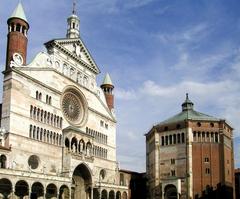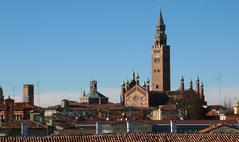
Cremona–Asola Tramway: Visiting Hours, Tickets, and Visitor Guide
Date: 04/07/2025
Introduction: A Journey Through Lombardy’s Industrial Heritage
The Cremona–Asola Tramway is a significant historical landmark in the Lombardy region of Northern Italy, offering a unique window into the evolution of early 20th-century regional transportation. Inaugurated in 1929, this 32-kilometer line connected Cremona—a city celebrated for its violin-making legacy—with Asola, a rural hub in the province of Mantua. Powered by steam locomotives until its closure in 1955, the tramway played a vital role in the economic, social, and cultural development of the area.
Today, the legacy of the Cremona–Asola Tramway endures. Visitors can explore preserved station buildings, trackbeds, interpretive trails, and museum exhibits that tell the story of a transformative era in regional mobility. The tramway’s influence extends beyond transportation: it fostered economic growth, social cohesion, and regional integration, while its infrastructure—stations, bridges, and depots—stands as a testament to the engineering ingenuity of the time.
This comprehensive guide provides detailed historical context, practical visitor information, travel tips, and recommendations for making the most of your visit to this remarkable site. Whether you are a history enthusiast, outdoor adventurer, or cultural traveler, the Cremona–Asola Tramway offers an enriching journey through Lombardy’s vibrant past and present (Cremona Tourist Information Center, History of rail transport in Italy, Museo del Violino).
Table of Contents
- Overview: Why Visit the Cremona–Asola Tramway?
- Historical Significance and Legacy
- Visiting Today: Sites, Hours, and Accessibility
- Tickets, Tours, and Visitor Tips
- Nearby Attractions and Recommendations
- Sustainable Mobility and Community Heritage
- Frequently Asked Questions (FAQ)
- Useful Resources and Contacts
- Conclusion
Overview: Why Visit the Cremona–Asola Tramway?
Although the tramway ceased operation in 1955, its route and legacy have been carefully preserved. Today, visitors can discover remnants such as restored station houses, scenic walking and cycling paths, and informative museum exhibits, all reflecting the region’s rich industrial past. The tramway route traverses picturesque Po Valley landscapes and links to notable cultural sites, making it a top destination for those interested in transportation history and regional Italian culture.
Historical Significance and Legacy
Regional Progress and Connectivity
The Cremona–Asola Tramway was a key player in regional modernization, connecting rural and urban communities and enabling the flow of goods and people. Its construction mirrored broader European trends, as tram systems drove economic integration and social mobility across Italy (History of rail transport in Italy).
Architectural and Engineering Achievements
The line’s infrastructure—such as the bridges spanning the Po and Oglio rivers—demonstrates impressive engineering for its time. Many original structures, including stations and depots, still exist, some repurposed for community use or preserved as heritage sites (Tranvia Piacenza-Cremona).
Economic and Social Impact
The tramway enabled rapid, reliable transport of agricultural products to city markets, supporting local farmers and artisans. It also fostered population growth and urban development along its route, while becoming a symbol of social progress, referenced in local literature and oral history.
Cultural Memory and Preservation
Although the line is no longer active, its memory is kept alive through museum collections, local archives, and special events. Community-led initiatives continue to celebrate and protect this important piece of Lombardy’s heritage (TravelPander).
Visiting Today: Sites, Hours, and Accessibility
Location and Access
- Starting Point: Cremona city center, accessible by regional train or car via the A21 autostrada.
- Route Highlights: Key sites include the former stations at Montanara, Casalmaggiore, and Asola, as well as preserved trackbeds and interpretive panels.
- Walking and Cycling: The old tramway alignment is now a popular route for walking and cycling, with generally flat terrain suitable for all fitness levels (OpenHistoricalMap).
Visiting Hours
- Outdoor Sites: Accessible year-round, free of charge.
- Museums and Tourist Office:
- Cremona Tourist Office: Mon–Sat, 9:00 AM–6:00 PM; closed Sundays and holidays.
- Museo del Violino: Typically daily, 9:00 AM–6:00 PM (check for updates).
- Civic Museum: Tue–Sun, 9:00 AM–5:00 PM; closed Mondays.
Accessibility
- Many urban sites and museums are wheelchair and stroller accessible.
- Rural sections of the route may have uneven terrain; check with the Tourist Office for detailed guidance.
Tickets, Tours, and Visitor Tips
Tickets
- Tramway Trails: Free access.
- Museums: Admission fees range from €5–€10; discounts available for students and seniors.
- Guided Tours: Book through the Cremona Tourist Office or official online providers. Private tours (in English/Spanish) are available (Travel Buddies).
Visitor Tips
- Best Time to Visit: Spring and autumn for mild weather.
- What to Bring: Comfortable shoes, sun protection, water, and a camera.
- Bike Rentals: Available in Cremona; some hotels offer complimentary bicycles.
- Recommended Stops: Parco Colonie Padane (family-friendly), local trattorias for regional cuisine.
- Maps and Info: Obtain at the Tourist Office or download from official tourism websites.
Nearby Attractions and Recommendations
- Cremona Cathedral and Torrazzo: Iconic landmarks near the tramway’s starting point.
- Museo del Violino: Explore Cremona’s world-renowned violin-making heritage (Museo del Violino).
- Po Valley Countryside: Ideal for cycling and photography.
- Local Museums: Civic Museum and heritage sites along the tramway’s former path (Culture Activities).
Sustainable Mobility and Community Heritage
The tramway’s legacy informs modern sustainable transport policies in Lombardy. Operators like Arriva Italia promote energy-efficient mobility solutions, drawing on the region’s historic tram systems as a model for greener urban development (Arriva Italia).
Historic tramways continue to inspire community identity and responsible tourism, with efforts focused on preservation, accessibility, and public engagement.
Frequently Asked Questions (FAQ)
Q: What are the visiting hours for the tramway sites and museums?
A: Outdoor trails are open year-round. Museums and the Tourist Office operate generally from 9:00 AM to 5:00/6:00 PM, with some closures on Mondays or Sundays.
Q: Are there entrance fees?
A: The tramway trails are free; some museums and exhibits charge admission.
Q: Are guided tours available?
A: Yes, in Italian and English. Book in advance through the Tourist Office or reputable tour providers.
Q: Is the tramway route suitable for families and cyclists?
A: Yes, the route is flat and family-friendly; bike rentals are widely available.
Q: Are sites accessible for those with limited mobility?
A: Most urban sites and museums are accessible, but some rural paths may be uneven.
Useful Resources and Contacts
- Museo del Violino Official Site
- Travel Buddies - Cremona Guided Tours
- Rome2Rio - Cremona to Asola Transport Options
- OpenHistoricalMap - Cremona–Asola Tramway Route
- Arriva Italia – Cremona
- Martha’s Italy
- Petit Futé
- Culture Activities
- TravelPander
Conclusion: Preserving a Living Legacy
The Cremona–Asola Tramway remains an enduring symbol of Lombardy’s industrial progress, social unity, and commitment to sustainable mobility. By walking, cycling, or touring the route and its heritage sites, visitors immerse themselves in a story where past innovation meets present-day stewardship. Support preservation efforts and enhance your visit by consulting official channels for current information, guided tours, and special events.
For interactive maps, audio guides, and up-to-date event listings, download the Audiala app and follow Cremona’s official tourism platforms. Embark on a journey where the echoes of steam locomotives lead you through scenic landscapes and vibrant cultural traditions—a testament to Italy’s living heritage.




